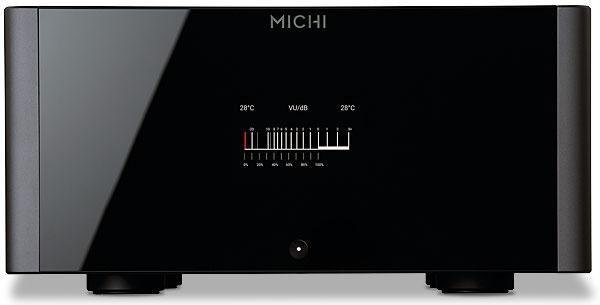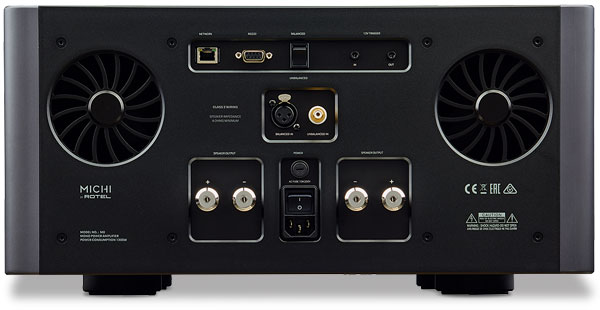Rotel Michi M8 Mono Power Ampiifier

 It looks like the S5 stereo power amp, both inside and out, but the Michi M8 monoblock is altogether more powerful and, as a result, offers a sound with a charm all its own
It looks like the S5 stereo power amp, both inside and out, but the Michi M8 monoblock is altogether more powerful and, as a result, offers a sound with a charm all its own
You'll have to examine the £5399 Michi M8 monoblock power amp very closely to see how it differs from the company's S5 stereo model, reviewed previously alongside the £3299 P5 preamplifier [HFN May '20]. The two are the same price and size, look identical and have much the same 'ask a friend to help' mass. In fact, the M8 weighs marginally less than the S5, at 59.1kg – the difference presumably accounted for by the need for two-channel inputs on the stereo amp whereas the mono version has only single-channel connections, on both balanced XLR and unbalanced RCA sockets.
I use the term 'version' advisedly since, when one gets out the old toolbox and pops the lid – or should I say 'hefts' given the sheer solidity of this and every panel – off the amp you'd be hard pressed to see the differences there, too. Very much in evidence are the two in-house-wound transformers, in their substantial shielding 'cans', behind which sit four massive British-made custom smoothing capacitors, while at either side are placed the two fan-assisted heatsink 'tunnels' for the output devices. The fans are sufficiently muffled that the chances are you won't ever hear them running unless you go crawling round the back of the amp listening for them.
Major Power
There's even the same multi-mode display on the M8's fascia, its various readouts and graphics selectable using the supplied remote handset, which can also be used to fire up the amp or put it into standby. I'll come back to that display panel later, if only because I didn't quite cover how comprehensive it was in our P5/S5 review a few months back.

So what actually does set the M8 apart from the S5? Well, apart from the mono input connections, with a switch to select between RCAs and XLRs, you might be forgiven for thinking this is still a stereo amp, as it has two sets of substantial speaker terminals on the rear, good for banana plugs and chunky spade terminals or – if you're feeling brave, bare wires. In fact, the two are permanently powered when the amp is working, with not a sniff of a selector switch, so those with a penchant for bi-wiring their speakers will be happy.
The main differentiator is the power output, for the S5 stereo claims 500W/8ohm, rising to 800W/4ohm – figures PM's lab tests prove are very much on the conservative side, while the M8 is rated at 1050W/8ohm, and 1750W/4ohm. If the S5 could be said to deliver 'sufficient power', as the Rolls-Royce saying used to go, the M8 goes way into 'more than you'll ever need' territory.
On Display
The interesting thing here is how the M8 achieves those prodigious power outputs into 8 and 4ohm at least. I've already mentioned the fact that it uses the same transformers, and that same quartet of slit foil, low-ESR bulk storage capacitors as the S5, so you won't be surprised to know that the other major feature of the amplifier, the 32 high current output transistors, are also shared with the stereo model.

Even the extra facilities on offer are the same, extending to an Ethernet port for firmware upgrades, an RS232 control port, and 12V trigger inputs and outputs to allow the amplifier to be switched in and out of standby by a remote device, including the P5 preamp. In addition, all Michi products react to the same on/off commands from the system handset.
With connections made and the main power switch on both amps set to 'on', the M8s can be fired up using either the main panel on/standby button or the remote handset. That done, and with the front panel LED changed from red (for standby) to white (on), the set-up menu can be accessed using the remote, allowing adjustment of the network connection for firmware updates and/or IP control in custom installation, and selection of the various display modes available.
The brightness of both the display and the front panel LED can be adjusted – both are set to maximum brightness as default, but can be taken down through four steps of dimming. Then there are the display options where the panel can show either a dB peak power meter, or a spectrum analyser readout with a choice of 12-band as a default, or 8- or 16-band versions.


















































